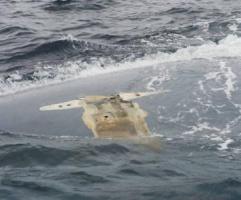
Cheeki Rafiki without her keel
We posted yesterday about the death of Dutch yacht designer Frans Maas and two of his crew when the fin keel broke off from Capella, a boat he designed and owned. The boat capsized without warning and the three sailors drowned.
Sadly, keel failure is a common enough occurrence that the folks at the Sailing Anarchy blog to have coined a name for it — keel kills. The sudden detachment of a fin keel from a fiberglass sailboat hull too often ends up with one or more dead.
In May of 2014, the Beneteau 40.7, Cheeki Rafiki , on a trans-Atlantic delivery voyage, lost its keel. Four sailors aboard died. What was so disturbing about the incident was that the Beneteau 40.7 was considered to be a well built and durable boat. There were around 800 of the 40.7s produced and most are still sailing.
The problem is not limited to mass production sailboats. In 2015, the Polina Star III – a custom extended 90ft version of the Oyster 825 lost its keel and sank while sailing off Spain. Fortunately, five crew were rescued by the Spanish Coastguard before the vessel sank.
In May 2013, a Bavaria 390 lost her keel 650 nm north-east of Bermuda. The crew of two was rescued. In the 21011 Fastnet Race, the 100′ long supermaxi Rambler lost her keel and capsized. Remarkably all 21 of her crew were rescued. In June of 2008, Cynthia Woods, a Cape Fear 38, lost its keel while racing in the Gulf of Mexico. One crew died. Hooligan V, a Max Fun 35, lost her keel in 2007. One crew member died. A Bavaria Match 42 lost her keel in 2005 with the loss of one crew. In the same year, Moquini, a Fast 42, lost her keel off South Africa, killing six. Excalibur, a 15-metre racing yacht, lost her keel in 2002, with the death of four. And on and on.
The International Sailing Federation (ISAF) commissioned a Keel Structure Working Party to investigate and report on the problem in 2015. They investigated 72 known cases of lost keels that had reported since 1984 and which involved no fewer than 24 deaths by drowning. It is unknown how may keel failures were responsible for sailboats and their crews which simply disappeared.
The underlying problem is that keels have evolved from being an integral part of a sailing vessel’s structure to becoming a thin and heavy appendage, connected to the hull as a highly stressed cantilever. Looking at many fin keels today raises the question of not, why do they fall off, but how do they stay connected?
There appear to be an overlapping list of why fin keels fail.
- The original design may be flawed, under engineered or improperly fabricated.
- Over time, loading from normal sailing or sailing in storm conditions can weaken the supporting structure to reveal latent defects in the design.
- Grounding or collision with underwater objects can weaken the keel support structure. The damage to the structure may not be be obvious.
- All three causes may be present. Poor design, accumulated wear and tear and minor groundings or collisions may collectively lead to catastrophic keel failure.
The design of modern fin keels is a serious engineering challenge where failure has a significant human cost. How many more will die before we get it right?

Stop building cruising boats to racing rules.
You’re using a typical SA tongue in cheek article title to back up your argument? Also are you really slamming yacht designers while the Frans himself was the designer of the boat he was on? Very quick to point fingers while not knowing the whole story.
We have gotten it right in the Past.. Time to honor those designs and reproduce them..
I so often have wondered about the flawed decision to sail the oceans trawling for cargo nets and other sea debris with dagger keels and isolated rudders. I feel much more at ease with my rounded, full keel and large, integrated rudder.
Add failure cables that can be re attached or cranked back in place
The critical part of the story is that the keel fell off, resulting in the deaths of three people. Do you deny that?
caveat emptor
The Ericson 27 has a fiberglass encased lead keel. So nice.
What happened to Angus Primrose?
Why do racers keep making excuses for this?
Using current inflatable life boat technology, install an inflatable collar around the boat at the water line. It would activate with keel lose and give the crew more time to escape.
Not to slight the general problem but indeed Cheeki Rafiki had experienced multiple keel strikes in her career with at least one leading to structural damage, repair of which left questions hanging in the air.
Excellent MAIB report:
http://www.sailing.org.au/wp-content/uploads/2015/04/MAIBInvReport_8_2015.pdf
Owning a charter boat is a bit of an eye-opener on this general topic. Despite no-brainer chart plotters, depth sounders and all best efforts to encourage actual navigation boat crews will still find things to hit and then remain clam about it. As the MAIB indicates, reported crunches are only some fraction of actual experience.
Fin keel boats are made for performance, not smashing into rocks, dropping onto sandbars etc. Groundings are best handled with a full keel. After that, honest confession is best.
I’ve sailed in Drum, which also Lost her keel off the UK, butbtebuilt snd sailing in the Whitbreadcrace for Uraguay
Pingback: Keel Failure and the Deadly Inversion - Topmast